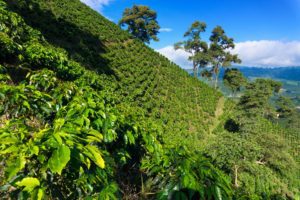From Heating Muffins to Finessing Rare, High-Altitude Coffee Drinks - A Day in the Life of a Barista
Most adults and teenagers have seen a barista brew coffee delights at a coffee shop. Intrigued barista-watchers may wonder: is it worth it to learn to pull espresso at a break-neck pace and memorize the attributes of high-altitude coffee? Executing the whirlwind of basic coffee maneuvers mixed with complicated ones does catch the eye of coffee lovers. Whipping up coffee or espresso and plating muffins while carrying on a conversation isn’t for everyone though. A lot more goes into being a barista than most people realize. The demanding pace and cleaning involved aren’t always glamorous. Nevertheless, this is a fun and rewarding job for coffee enthusiasts, fast-movers, people lovers and others.

Barista Preparation
An aspiring barista can learn the skills they’ll need on the job or in class. In the US, most people start learning on the job. In other countries that pay baristas a high base rate, learning at a school is common. Espresso machines and other coffee equipment can be expensive. Even with the advent of YouTube tutorials, many people don’t find the means or counter space to invest in learning complicated drinks at home. So, learning on the job is fun. Learning through formal training can launch a great career or fun stint as a barista too.
Barista Duties Before Customers Arrive
Enlisting as an early shift barista means committing to operating well in the morning. Whether that happens by nature or caffeine varies. A morning work ethic and smile are hardly optional, however. Baristas arriving at the coffee shop, usually before 6 am, may need to assess whether the closing work was done well and where gaps lie. Is there enough of each type of dairy? Are the mugs, counters and machines clean? Did the rare high-altitude coffee arrive yesterday? Ensuring the customer seating area is presentable before the doors open starts the day right.
Baristas can’t overlook the till either. Having enough change in the registers and ensuring the POS system is operating are key. Depending on the complexity of the foods the shop offers at certain hours, they may need to prepare food for on-demand cooking and make a stock of pastries and muffins accessible. Hopefully, some tasty-looking examples are ready to put on display.
Here They Come
Upon opening the door or at the onset of the morning rush, baristas must ensure they can greet customers with a smile and comply with orders. Customers usually arrive before normal weekday office hours. There may be another rush around lunchtime. On the weekends, those hungry for caffeine may stream in during all waking hours. Rushes can occur around breakfast and lunch times on weekends too.
As a barista, it’s not always easy to stay prepared and on top of tasks. That’s why working well in a team makes all the difference. When the first customer expects a barista working solo to chat them up about the delectable high-altitude coffee brewed in a pour-over, but the barista still needs to stock behind the counter, trouble results. The customer line can back up. Baristas may find themselves “in the weeds,” or overwhelmed early on if they’re not prepared. Teamwork and sound oversight from a manager can be crucial. Not only does this keep the coffee line moving, but great management and teamwork can advance the skills of newer baristas. Learning barista skills on the job can take months. In a small town or an out-of-the-way shop, a few weeks may suffice. However, when people often order complicated drinks with particular types of milk, barista skills stay in higher demand and must get transferred to new hires quickly. That’s especially the case in urban coffee shops. Tourist destinations or even small towns in coffee-loving western Oregon and Washington require primo barista skills.

Brewing and Maintenance Work
Brew, heat a quiche, pull espresso, brew! Coffee shops can be busy places. Remembering a customer’s spelling of Ashley/Ashlee/Ashleigh (“with two E’s”) to write it on the cup after five minutes of filling orders is no joke either. Baristas strive to maintain care for crafting coffee among competing demands. Luckily, many coffee shop frequenters reward baristas who remember the details. Executing half-soy milk and half-oat milk in Greg’s iced latte every weekday may make him stop in on Saturdays too. Anastasia may leave a five-dollar tip for finishing her seven employees’ drinks quickly and putting them into nice carrying cartons. While the tips don’t rival food service, the need to schmooze isn’t as high. Likewise, the length of conversations and the duration of fulfilling one order are shorter.
Since coffee shops run on liquids, food, machines and dishes, the need for continuous work and stocking contributes to the fast pace. The constant brewing, restocking and cleaning favors proactive and high-energy people. Luckily, most coffee shops offer baristas all-you-can-drink delights. Two well-timed cappuccinos with extra cinnamon can reward an organized and efficient barista over the course of their shift. As long as you hydrate too, coffee can even be good for you!
Closing a Shift
The end of some baristas’ shifts will coincide with the closing of the shop. If the coffee-producing establishment is open later, another barista or two will take over. Regardless of the situation, when a barista departs, there is often work required to close the shift. Ensuring that the baristas taking over have enough supplies and know about any shortages, new machine quirks or complicated upcoming orders is important. Ordering and stocking of run-of-the-mill or high-altitude coffee grounds or beans will keep even the most obscure menu items accessible.
If a barista must close the shop for the day, cleaning and restocking are in order. Most shops order in bulk and have large closets and refrigerators holding a stock of supplies. Nevertheless, since coffee shops often open before the sun peeks over the horizon, filling any supply gaps for the next morning can be vital. Baristas should fix or report any problems with the POS, refrigerators, dishwashers or coffee machines to management or the owner. Luckily, it doesn’t take long to learn the proper setup for behind the counter. Afterward learning the ropes, restoring the shop to a ready state is easier.
Finally, baristas looking to continue their day outside the shop usually tidy the customer area. Unless there is a cleaner, as in a mall or grocery store coffee stand, the tables and floor need cleaning. Passersby may peer into shop windows when it’s closed. Wiping the tables off, restocking sugar and napkins then sweeping underneath will get things in order for the afternoon or the next day. The area where cream and fixings lie needs cleaning and restocking too. Emptying the trash is often a final, crucial step.
Baristas and the International Coffee Opportunity
Many coffee lovers, along with the average Joe, don’t realize that in the twenty-first century, a barista serves as a link in a worldwide coffee network. Few jobs have such traceable international implications. Not only are there worldwide implications, in the information and service-based economy, coffee is also an age-old physical product. It’s one that creates jobs, community and good times! Thanks to computers, fewer and fewer jobs produce a physical result nowadays. Serving coffee is a way baristas can carry on a centuries-long tradition of…enjoying a cup o Joe.
If you decide to start a role as a barista, delve into the coffee you serve and its origins. Coffee beans from Honduras, Colombia or Ethiopia have exciting new tastes. Try different single-origin coffees. They reflect the particular growing conditions on a coffee farm that year. Between coffees grown in different places, so many factors can vary. It’s not all about high-altitude coffee. The rainfall, sunshine, and temperature on one farm can vary each year. In different locales, single-origin coffees reflect those geographic and climatic conditions.

Try High-Altitude Coffee from Honduras
High-altitude coffee from the very tallest mountains gets overrated. At Subida Coffee Co., we refined our single-origin beans from the mountains of western Honduras where the perfect “eternal spring” reigns all year. We craft our beans into a dark roast and a medium roast offering consistent, delectable flavors. They come in several forms. Whole beans, ground coffee and single-serve pods can arrive via a subscription model, and for a great cause.

